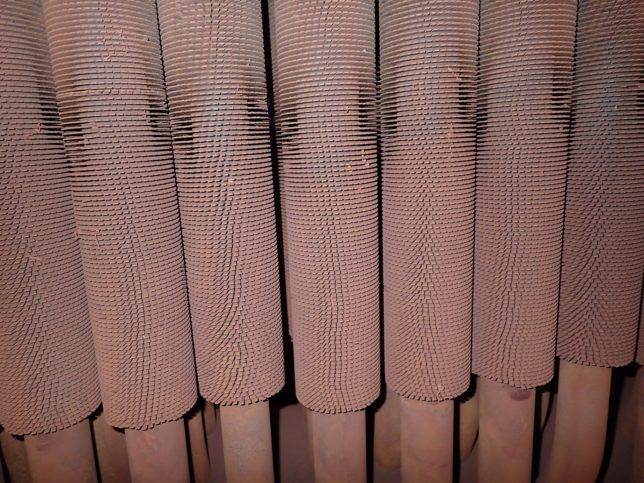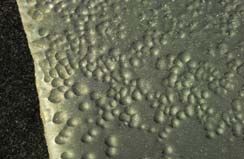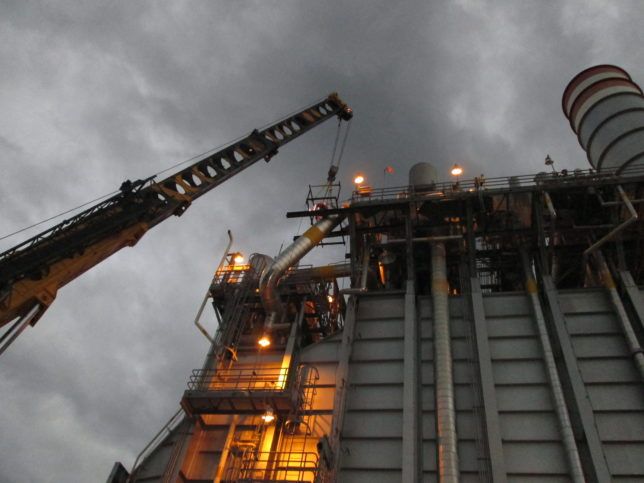HRSG Forum Report
How to cope with increasing cycling, start and ramp-up issues plaguing heat recovery steam generators.

The combined cycle power plants (CCPPs) built in the 1990s and 2000s were designed for baseload operation. But a quarter of a century later, the picture has changed dramatically. With renewables flooding onto the grid in unprecedented numbers, CCPPs are being forced to cycle, start, ramp and load faster.
The Achilles heel in this new mode of operation is the heat recovery steam generator (HRSG). Subjecting HRSGs to constant shifts in temperature causes problems such as exfoliation, tube failures and other damage as the systems were not designed to cope with cycling.
“Exfoliation is a combination of long service at high temperature, which builds the oxide layer then thermal cycling that causes exfoliation,” said Bob Anderson, an HRSG expert who is Principal at Competitive Power Resources. He spoke at the HRSG Forum, which met in Orlando, Florida in July 2019 to delve into every aspect of HRSG operation, maintenance and repair.
Anderson, the technical leader of the event, introduced Eugene Eagle, Lead HRSG Engineer at Duke Energy’s Carolinas Natural Gas Regional Engineering Services. Eagle detailed the company’s experience in preparing HRSGs for cycling operation. “Like many utilities, Duke is anticipating substantial growth of renewable generation that will require more flexible operation,” said Eagle.
Some plants will be shutdown, he said, with others being readied to ramp up rapidly and run in low-load operation. The Duke fleet has been practicing cycling with grid operators to gain operational experience. This is being done to pre-emptively find and correct issues in gas turbines (GTs) and HRSGs. The goal is to find out how to operate these units in a cyclic mode while mitigating thermal and mechanical fatigue damage. Most of the Duke GTs are F-class units in combined cycle plants, including triple-pressure HRSGs with duct firing. Current estimates have reduced expected design life from 30 to 20 years due to cyclic rather than baseload operation.
“With daily cycling there is a significant reduction in design life due to delta temperature changes,” said Eagle. As a result, the company is implementing best practices to avoid fatigue damage and other cycling issues. By improving startup and shutdown procedures, fatigue on HRSG pressure parts is reduced, and maintenance costs are lowered with fewer forced outages. “We manage the asset rather than the asset managing us,” said Eagle.
He strongly recommends instituting such practices to avoid tube repairs. Slow starts are the best, he said, as they cause the least amount of damage. Cold ambient starts cause the most damage as you have to heat up thick, high-pressure parts in an uncontrolled manner early in the cold start. Duke measured the estimated thermal fatigue damage per cycle event. A turbine trip and immediate restart was by far the most severe, followed by cold ambient starts and forced cooldowns. Normal shutdown is done at 2°F per minute GT exhaust temperature. A forced shutdown, on the other hand, is done at 5°F.
Eagle said it is difficult to maintain hot startup conditions (which require more than 500 psig HP drum pressure) due to various factors, such as auxiliary steam requirements, drain operation, pre-start purge, leaking valves and lack of a stack.
Further challenges include drain system designs with varying performance between sites, gaining staff and management buy in and drain pot thermocouples not working for hot startups. Additionally, Eagle noted gas turbine differences between OEMs. He contrasted the different exhaust gas temperature pro-files during startup of the GE 7FA and the Siemens 5000F.
With regard to superheater and reheater drains, Eagle mentioned that logic upgrades have been completed at most sites to automatically keep drains closed for the hot shutdown but still maintain the ability to cycle open when necessary as designed.
Further tips:
• Make sure the drain system can cope with the volume of condensation generated during startup and the amount of water present due to attemperator leakage (which should be zero)
• Avoid reducing attemperator set-points below 1,050°F. It is better to over-shoot on steam temperatures than to over-spray to saturation
• Double block and bleed valve configuration on attemperator spray water are best to prevent leak-by, or use upgraded full-metal seated ball valves
• Always maintain drum saturation temperature and steam temperature ramp rates within OEM recommendations. “We continue to have spray-to-saturation events especially during startup and shutdown that are very damaging to steam piping downstream elbows and HRSG pressure parts,” said Eagle. “We have made modifications to GT exhaust gas temperature profiles during startup to help reduce or eliminate such issues.”
Hot shutdown best practices:
• Always use exhaust temperature matching for every startup and shutdown on the GE 7FA
• Steam cool the HP superheaters within 50°F of saturation during shut-down as this reduces damaging differential temperatures and the impact of condensate quench
• Ensure both the HP drum saturation temperature and HP steam temperature ramp rate limits are not exceeded during shutdown
• After transfer to bypass valves, build HP drum pressure back up to 1,600-1,800 psig with bypass valves
• Complete a final stabilization of around five minutes at the GTs minimum load before ceasing to fire.

HRSGs can suffer from a variety of problems including rust, build up of oxide, exfoliation and tube failure
Jake Waterhouse, Director of Dekomte de Temple, discussed casing penetration seal solutions and Dekomte expansion joint technology. He contrasted metallic bellows with fabric expansion joints (his company offers both).
The traditional metallic bellows have lower initial cost and are well regarded for first-time installations. They generally use single-ply stainless steel, and are suitable for axial movement but can accept minimal lateral movement. Possible issues include convolution, distortion, splitting and corrosion of the seals. “Fabric seals have anywhere from one-to-four layers of loosely packed insulation and have greater flexibility in the most compact designs and are favored for high movement areas,” said Waterhouse. “Possible issues include tearing of the fabric and loosening of the clamp bands.”
He added that visual and thermographic inspection is vital to understand the existing scene and see what is needed. This makes it possible to evaluate the fabric belt as well as the associated insulation. Maintenance personnel can then dis-cover what joints are likely to fail and take preemptive action. “CCPPs endure greater challenges due to duct fatigue during temperature transients and irregular stress caused by movement,” said Waterhouse. “Fabric expansion joints are the best option for retrofits.”
HRSG chemistry
Barry Dooley, a Consultant at Structural Integrity Associates provided an update on cycle chemistry for combined cycle HRSGs, using data based on over 100 plant assessments world-wide. It included the latest chemistry guidance concerning the use of film-forming substances in HRSGs and air-cooled condensers (ACCs).
“Flow accelerated corrosion (FAC) is the number one problem in HRSGs,” said Dooley. This applies to power plants with HRSGs, as well as industrial plants, LNG producers and nuclear facilities. FAC is found mainly in evaporative and HP economizer tubing. However, plant personnel are not identifying the type of FAC correctly (single-phase or two-phase FAC).
Single phase FAC has a mottled surface like an orange peel and is often red in color. You can see markings like chevrons pointing in the direct of flow. Two-phase FAC typically can be identified with a black, shiny surface, and has small dimples instead of chevron markings. Therefore, it is vital to adjust chemistry to address FAC.

Example of the dimples often found in two-phase flow accelerated corrosion
Dooley also covered film-forming sub-stances (FFS). FFS is sometimes needed, but not always, he said, and cautioned users to be wary of vendor claims that FFS are suitable for all-ferrous and mixed metallurgy feedwater systems. This is not necessarily the case. Experience in the field indicates some problems after FFS has been added. This included increased oxide deposition in boilers and turbines, and tube failures.
“If you don’t get the chemistry right, you can have massive amounts of iron coming out of the ACC due to FAC,” said Dooley. “If you apply IAPWS TGD8-16 Section 8 for any FFS deposition, you will have no problems with chemistry.” He referred the users to the IAPWS website (IAPWS.org) as well as his own organization’s literature for more details.
Dooley went on to discuss repeat cycle chemistry situations (RCCS) based on study of 220 plants. RCCS, he said, relates to the basics of power plant chemistry and thus plant reliability and performance. If a plant has more than two or three RCCS indications (such as presence of corrosion products, evaporator deposition, contamination ingress, drum carryover and air in-leakage), this means they will have a problem in the near future. “It is important to watch out for the presence of RCCS, recognize the negative impact and develop action plans to correct it,” said Dooley. “RCCS should be an inte-gral part of any corporate chemistry directive.”
Creep strength
Creep-strength-enhanced ferritic (CSEF) steels, also known as Grade 91, are metallurgically complex alloys that achieve improved elevated temperature strength through controlled chemical composition and heat treatment. However, the quasi-stabilized structure produced in CSEF steels slowly breaks down under the influence of stress at high temperatures.
Originally developed by Oak Ridge National Laboratory and Combustion Engineering, the first major installations were in the 1980s. Since that time, Grade 91 has been favored in the power industry where thermal cycling was anticipated (such as in HRSGs).
Jeff Henry, President of ATC, a materials engineering services company, said the ASME had reduced the allowable stress limits for Grade 91 steel. This action has caused some confusion at plant level over the impact on future operation of plants with Grade 91 pressure parts, he said. A type II form of Grade 91 is being recommended. “For existing fleets, the reduction in allowable stress values does not mean operating equipment is suddenly at risk,” said Henry. “An assessment should be carried out to determine the significance of the change related to individual HRSG components.”
Stan Rosinski, Technical Executive at the Electric Power Research Institute (EPRI), followed with a characterization of pressure-wave cleaning for application to HRSGs. “Pressure wave cleaning was first introduced in 2015 and the results have been positive.”
Fouled tube bundles in HRSGs can penalize overall plant performance, he said. A common practice is to periodically perform a maintenance cleaning, generally when the pressure drop reaches an action-required level. Pressure-wave cleaning involves inflation and detonation of bags containing a gas mixture whereby the resulting over-pressure and pressure wave from detonation cleans fouled tube bundles. As a response to some of its members concerns over the possibility of damage to HRSG components, EPRI has been testing this technique to determine if tube damage is possible. To date, no damage has been observed in HRSG tube samples exposed to worst-case testing. A final technical report is expected soon.
Some users reported recent reheater tube failures, with oxide growth and exfoliation noticed in their HRSGs. Dooley and Anderson jointly covered how these problems were dealt with at the Bahia Bizkaia Electricidad (BBE) plant in Northern Spain.
Anderson said the 800 MW facility comprised two GE 9FA DLN 2.0 GTs (now DLN 2.6) and a GE D11 steam turbine, which had been operating for nearly 100,000 hours. Its Nooter/Eriksen triple-pressure boiler had a steam temperature of 565°C. Modifications to super-heater/reheater drains and attemperators have eliminated high-pressure superheater (HPSH) tube leaks, but reheater tube failures continue.
Dooley said maintenance personnel noticed oxide growth and exfoliation (OGE) in the steam circuits, perhaps due to more starts and cycling and fewer actual operating hours. BBE runs one unit for a week then shuts it down and runs the other one for the following week. Two re-heater tube leaks appear to be caused by severe and localized internal oxide exfoliation — possibly a first for this mechanism. “OGE has been an enormous problem in conventional fossil plants since the late 60s,” said Dooley. “Oxide on internal tube surfaces falls off and causes blockage, as well as solid particle erosion in the steam turbine and control valves.”
BBE experienced tube failures which appeared to be from thermal fatigue. Inspection revealed 50% of the wall thickness gone at the top and bottom of the tube, not at the sides. Localized internal oxide exfoliation was evident in the thinned areas. The probable cause was blocking or partial blocking at the bend in the tube leading to a heat spike and more oxide formation. Remediation actions have begun. Thermocouples have been added at the edge and middle of the module as a baseline to verify the heat spikes and to help assess tube temperatures. Radiography is also being used to find the amount of oxide present inside the tubes.
Ian Perrin, Vice President of Technical Development at Structural Integrity said the health of components suffering progressive degradation and damage has typically been achieved by performing Non-Destructive Examination (NDE). However, this can be costly. Success depends on being in the right place at the right time. Technology now exists to track the health (or aging) of key components, such as HRSG headers or piping components due to creep, fatigue, or in the case of attemperators, water impingement. Since leaking and overspray of attemperators are a common industry issue, Perrin provided an example of how online monitoring could identify when these events occur so corrective action can be taken, and damage evaluation conducted in a timely manner.
GT upgrades
GT upgrades have the potential to increase unit output, efficiency and flexibility. How-ever, the impacts of any proposed GT upgrade on the HRSG and the wider balance of plant (BOP) must be considered to ensure that new process conditions are acceptable, that any enhanced risks to process safety or component damage are understood and to ensure that the full capabilities and commercial value of the upgrade will not be limited by the water/steam cycle.
"You have to assess the impact on the water and steam cycle to determine if an upgrade is viable,” said Dan Blood, Team Leader for Steam Asset Engineering at Uniper Technologies. “The BOP might restrict the potential value of any upgrade.”Implementing a new GT package or update may shift the damage mechanisms in the HRSG. These risks must be understood. He said Uniper offers a process to answer these questions and mitigate risk.
Blood gave the example of plants wish-ing to implement GE’s Variable Load Path (VLP) upgrade on the GE 9FA/FB. VLP is a GT control feature that uses inlet guide vane control to keep exhaust temperature lower during startup. This significantly decouples the GT output from HRSG and ST constraints. The goal is to provide more MW in less time, lower the fuel burn, reduce load imbalance and start emissions, and lower startup costs. However, it causes a redistribution of heat through the HRSG’s gas path.
A detailed HRSG and ST assessment was done by Uniper. In the two plants studied, startup times would be reduced considerably. But modeling of the cold path predicted that the IP evaporator would be overwhelmed, and IP safety valve capacity would be insufficient. This needed to be mitigated by an exhaust flow boundary but would reduce the commercial value of the upgrade. One way to get around this would be to add an additional IP drum safety valve.

Installation of failed re-heater piping on HRSG
In the final presentation of the HRSG Forum, Bob Anderson summarized a new method for automatically controlling superheater and reheater drains. HRSGs have long suffered thermal fatigue damage due to failure to drain the large quantities condensate formed during startup. He discussed a new system developed by his company (Competitive Power Resources), EPRI and Flexim. The system uses Flexim ultrasonic flow meter equipment (with modified signal processing) to distinguish between water and steam in the drainpipes, then using this information to discharge water at the appropriate times without releasing steam. The system requires no penetration of the pressure boundary and is mechanically robust.
The 2020 HRSG Forum will be held July 20–23 at the Rosen Shingle Creek in Orlando. For more information, visit hrsgforum.com
